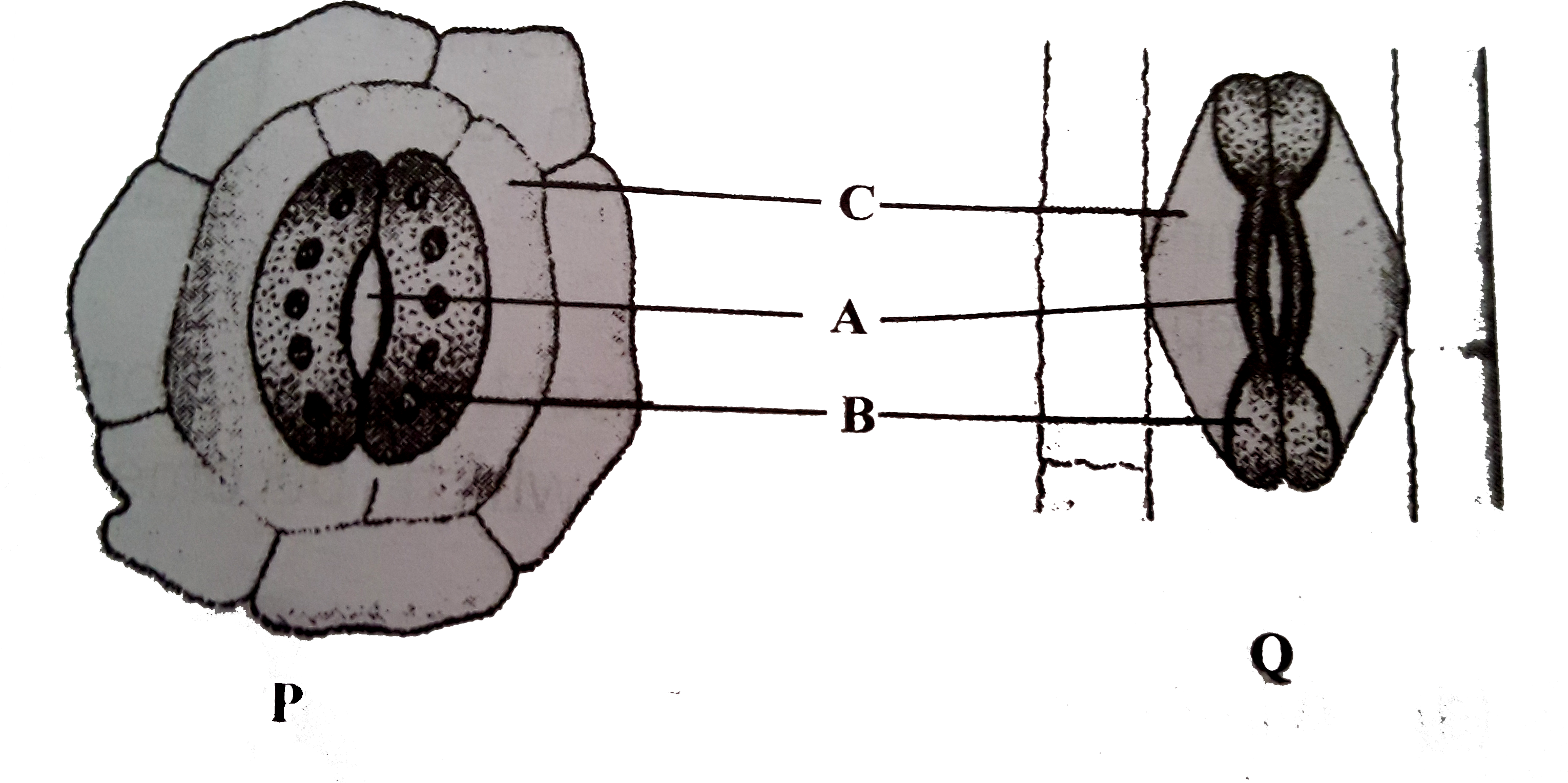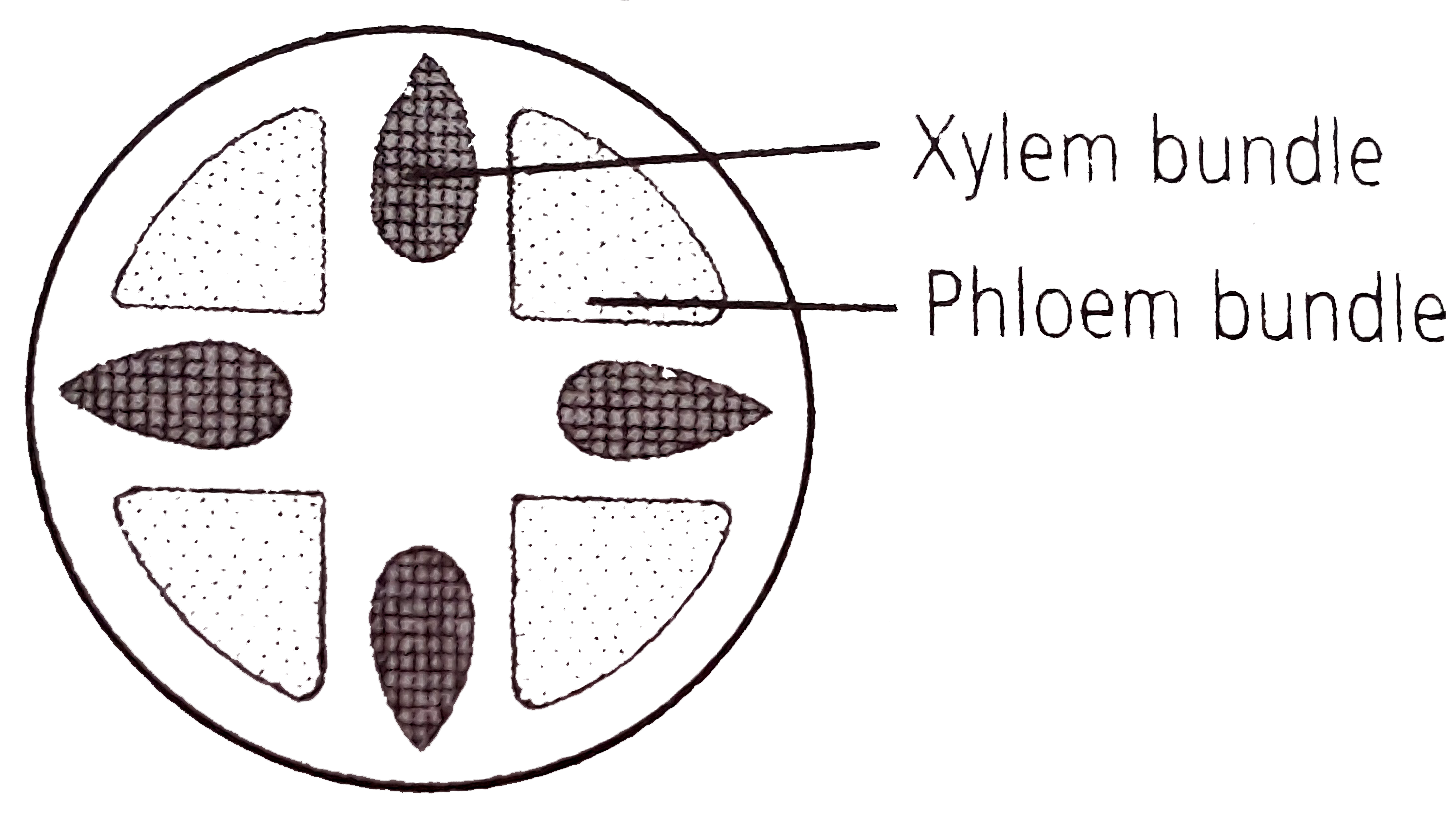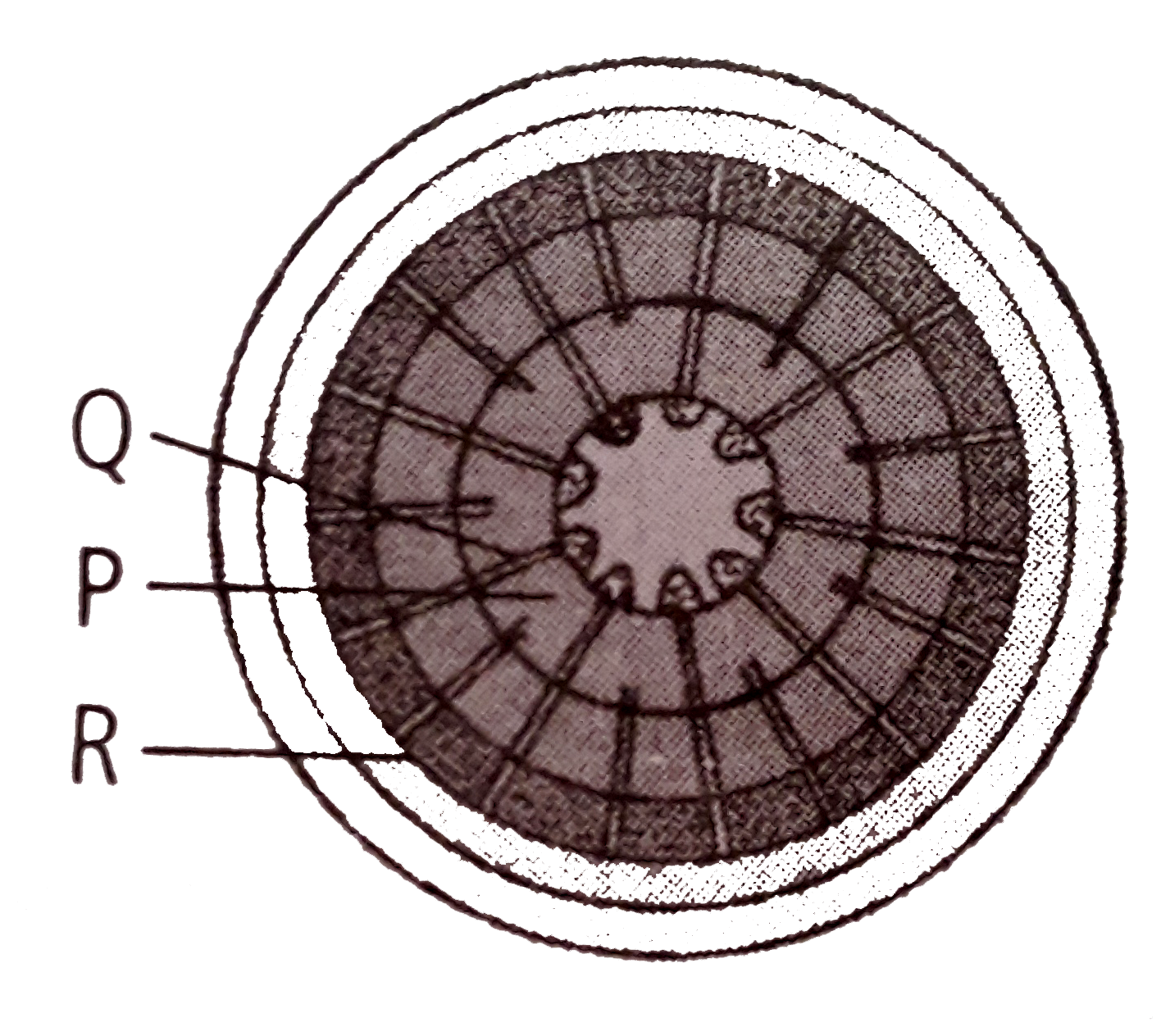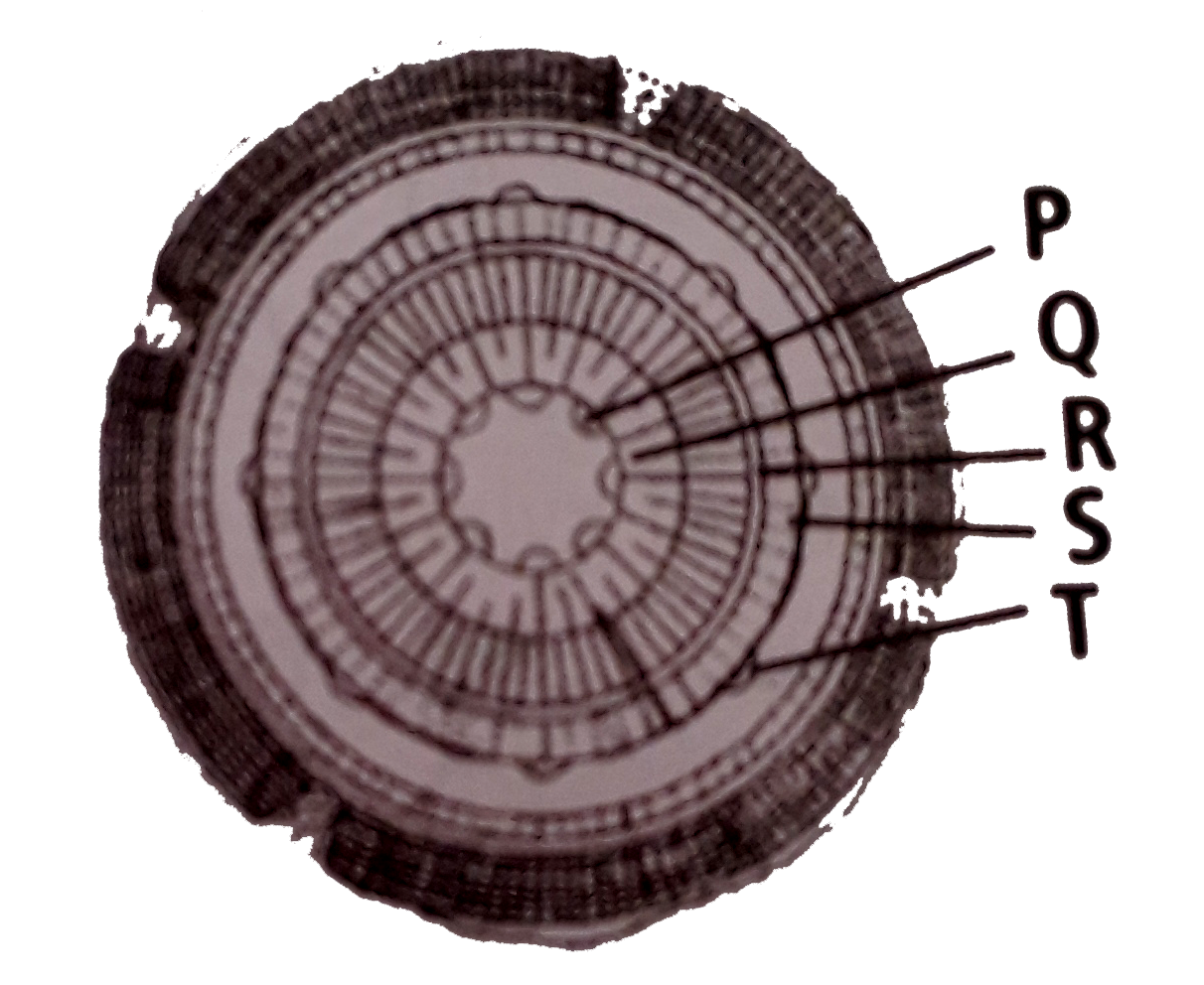Complete Solutions to Anatomy Of Flowering Plants of chapter ANATOMY OF FLOWERING PLANTS of Class 11 book with complete answers and questions
| Class 11 | BIOLOGY |
| Chapter | ANATOMY OF FLOWERING PLANTS |
| NCERT FINGERTIPS | Anatomy Of Flowering Plants |
| Number Of Questions | 100 |
| Academic Year | 2023-24 |
Meristematic tissues are composed of
View SolutionSelect the option that correctly identifies the labellings A, B and C in the given figure showing section of root apical meristem.

View Solution
Identify the given figure and select the correct option for A, B and C
View SolutionBoth apical meristem and intercalary meristem are ______Meristems.
View SolutionRead the followig statements regarding meristematic cells and select the correct ones.
(i). Cells possess the ability to grow and divide.
(ii). Cells have dense cytoplasm with prominent nucleus.
(iii). Well developed ER and mitochondria are present
View SolutionThe growth of roots and stems in length with the help of apical meristem is called
View SolutionVascular cambium and cork cambium are the examples of
View SolutionRoot cap in monocots is formed by
View SolutionThe cells of the quiescent centre are characterised by
View SolutionIncrease in girth of the plant as a result of the activities of primary and secondary lateral meristems is called.
View SolutionWhich one of the following is not a characteristic for meristematic cells?
View Solution________is a living mechanical tissue.
View SolutionIn angular collenchyma, thickenings are present ______
View Solution
The given figure present in
View SolutionWhich of the following tissues has dead cells with thick and lignified cells walls, having a few or numerous pits?
View SolutionIdioblasts are
View SolutionBone shaped sclerenchymatous cells found in hypodermal layers of some seeds and fruits are called
View Solution
The given figure shows which of the following cells?
View SolutionAll the xylem elements, when mature are dead except
View SolutionMatch column I with column II and select the correct option from the given codes.
`{:("Column I","Column II"),(A." Vessels",(i)." CElls are living, with thin cellulosic cells walls"),(B." Tracheids",(ii)." Cells possess highly thickened walls with obliterated central lumen"),(C." Xylem fibres",(iii)." Individual members are interconnected through perforations in their"),(D." Xylem parenchyma",(iv)." Elongated tube-like cells with thick, lignified walls and tapering ends"):}`
View SolutionWhich of the following is a vessel-less angiosperm?
View SolutionIn endarch condition of xylem, protoxylem lies ______of metaxylem.
View SolutionIn (i), protoxylem lies towards periphery and metaxylem lies towards centre. Such an arrangement of primary xylem is called as (ii)
View SolutionWhich of the following conditions of xylem is present in both monocot and dicot stems?
View SolutionRead the following statements and select the correct ones.
(i). Phloem parenchyma is absent in most monocots.
(ii). Gymnosperms lack tracheids and vessel.
(iii). Gymnosperms lack companion cells.
View SolutionIdentify the given figure and select the correct option for the parts labelled as A, B and C

View SolutionSelect the incorrect pair out of the following
View SolutionA common structural feature of vessel elements and sieve tube elements is
View SolutionVascular tissues of angiosperms differ from those of gymnosperms in
View SolutionMatch the scientists in column I with the related terms coined by them in column II and select the correct option from the given codes.
`{:("Column I","Column II"),(A." N. Grew",(i)." Hadrome and leptome"),(B." Nageli",(ii)." Tissue"),(C." Haberlandt",(iii)." Quiscent centre"),(D." Clowes",(iv)." Xylem and phloem"):}`
View SolutionThree types of tissue system have been recognised in plants on the basis of their functions. Select the correct option regarding this.
View Solution
Given figures (P and Q) represent the stomatal apparatus of dicot and monocot leaves respectively. Select the option which correctly labels A, B and C
View Solution
Identify the plants (from the list i-vi) which possess the given type of guars cells (as shown in the diagram) in their leaves.
(i). Grass
(ii). Tomato
(iii). Banana
(iv). Brinjal
View SolutionEpidermal tissue system is derived from
View SolutionSelect the mismatched pair
View SolutionWhich of the following exemplifies emergences?
View SolutionWhich of the following causes almost unbearable irritation of the skin?
View SolutionStomata which remain surrounded by a pair of subsidiary cells whose common wall is at right angles tio guard cells are called
View SolutionWhich of the following tissue systems constitutes bulk of the plant body?
View SolutionIn______vascular bundle, a strip of vascular combium is present in between the xylem and phloem.
View SolutionRadial vascular bundles characteristically occurs in
View Solution
Identify the type of vascular bundle as shown in the figure and select the incorrect statements regarding it.
View SolutionSelect the mismatched pair out of the following
View Solution
Identify the types of vascular bundle in the figures (i) and (ii) and select the correct option
View SolutionCasparian strips are the bands of thickenings present on _____walls of endodermis.
View Solution
A diagram of T.S. of dicot root is given, select the option which correctly labels A, B,C,D and E
View SolutionStele includes
View Solution
Transverse section of a part of a typical monocotyledonous root has been shown in the given figure. Identify the different parts (from A to I) and select the correct option.
View SolutionPolyarch vascular bundles generally occur in
View SolutionWhich plants part possesses polyarch condition of vascular bundles with a well developed pith?
View SolutionA typical monocotyledonous root is characterised by
View Solution
Following table summarises the differences between a monocot root and a dicot root. Identify the incorrect differences and select the correct option
View SolutionRead the following statements
(i). Multicellular epidermal hair
(ii). Collenchhymatous hypodermis
(iii). Pith present
(iv). Vascular bundles present in a ring i.e., eustele above given features describe which of the following plant parts?
View SolutionRead the following statements and select the correct option.
Statement-1: Anatomically, all the tissues present on the inner side of endodermis such as pericycle, vascular bunbles and pitch constitute the stele.
Statement-2: Eustele is the stele in which vasuclar bundles are arragned in the form of a ring as present in dicot stems.
View SolutionRead the following statement with 1-2 blanks in each one of them:
(i). In monocot root, a large number of vascular bundles are arranged in the form of a ______around the central _______.
Due to the presence of ______,the endodermal substances between cortex and pricycle, in primary dicot root.
(iii). The epidermis of stem of sunflower bears several unbranched _____hair.
(iv). The central portion of a dicot stem is usually occupied by_____comprising of thin-walled parenchymatous cells.
Select the option that correctly fills the blanks in any two of them
View SolutionVascular bundle is enclosed within a well developed sclerechymatous sheath in
View SolutionHypodermis is _____in sunflower stem and ______in maize stem
View SolutionWell developed pith is found in
View SolutionSelect the incorrect statement regarding the anatomy of a typical monocotyledonous stem
View Solution
Figures X and Y represent the transverse section of _____and ______respectively
View SolutionSelect the mismatched pair
View SolutionBicollateral vascular bundles are found in
View SolutionY-shaped arrangment of xylem vessel is found in
View SolutionLysigenous cavity in monocot stem vascular bundles develops by the dissolution of
View Solution
Refer to the given figure which represents a section of vascular bundles as seen in T.S. of a monocot stem and select the option that correctly labels A, B, C and D
View SolutionIn a dorsiventral leaf, location of palisade tissue and phloem is respectively on the ______surfaces.
View SolutionStomata are distributed more on the lower surface than on the upper surface in
View Solution
The given figure shows T.S of helianthus leaf with various parts labelled as A, B, C, D, E, F and G. identify the parts and select the correct option
View Solution
Identify A, B, C and D in the given transeverse section of leaf of Zea mays.
View SolutionIn a dorsiventral leaf, what is true regarding the position of xylem?
View SolutionBundle sheath extensions in a dicot leaf and in a monocot leaf are ______and______respectively.
View SolutionSelect the correct pair out of the following
View SolutionStudy the following statements regarding the anatomy of isobilateral leaf.
(i) Stomata are equally distributed on both the surfaces.
(ii) Certain adaxial epidermal cells are modified into bulliform cells in grasses.
(iii). The vascular bundles are radial
(iv). Phloem is adaxially placed.
Which of the above statements are correct?
View SolutionWhich of the following is an incorrect pair?
View SolutionIn dicot stems, cambium present between primary xylem and primary phoem is
View SolutionIn a mature dicot stem which has undergone seconday growth, youngest layer of secondary xylem is situated
View Solution
During the secondary growth in a dicotyledonous stem, the fusiform initials of vascular cambium give rise to which of the given labelled part?
View SolutionWhich of the following statements is correct about a woody dicot stem which shows extensive secondary growth?
View Solution
Identify P,QltRltS and T in the given T.S. of dicot stem showing secondary growth and select the correct options
View SolutionAs comprared to spring wood, automn wood has
View SolutionIn temperate regions, cambium is less active during winter season and forms fewer xylary elemetns that have narrow vessels, this wood is called as
View SolutionIn temperate regions, during spring season, combium is very active and produces a large number of cylary elements having vessel with wider cavities.wood formed in this way is called as
View SolutionRead the following statementsand selectthe correct option
Statement-1: Annual rings are distinct in plants growing in temperate regions
Statement-2: In temperate regions, the climatic conditions are not uniform through the year.
View SolutionIn old trees, central dark coloured, non-conducting part of secondary xylem is referred to as
View SolutionWhich of the following statements are correct about heartwood?
(i). It does not help in water conduction
(ii). It is also called alburnum
(iii). It is light in colour and is very soft
(iv). It has tracheray elements which are filled with tannins, resins etc.
View SolutionStudy carefully the following statements and select the incorrect one(s).
(i). Lateralroots develop from pericycle.
(ii) . Endodermis is the innermost layer of cortex
(iii). Sapwood is the central, dark coloured, non-conducting part of secondary xylem.
View SolutionMatch column I with column II and select the correct option from the given codes
`{:("Column I","Column II"),(A." Hardwood",(i)." Duramen"),(B." Soft wood",(ii)." Alburnum"),(C." Heartwood",(iii)." Non-porous wood"),(D." sapwood",(iv)." Porous wood"):}`
View SolutionThe terms 'wood' and 'bast' respectively refer to
View SolutionWhich of the following options carrectly shows the sequence of difference tissues fo the periderm starting from periphry?
View SolutionPhellogen cuts off derivatives on the inner side to form ______and on the outer side to form_____
View SolutionCork is impervious to water due to the presence of _______in its cell wall.
View SolutionBark does not include
View SolutionThe collective term used for phelloderm (secondary cortex), cork cambium (phellogen) and cork (phellem) is
View SolutionBark dormed early in the season is called as _____bark and bark formed towards the end of the season is called as_____bark.
View SolutionMatch column I with column II and select the correct option from the given codes. `{:("Column I","Column II"),(A." Stele",(i)." Innermost layer of cortex"),(B." Endodermis",(ii)." Suberin"),(C." Casparian strips",(iii)." All the tissues outer to vascular combium"),(D." Bark",(iv)." All the tissues inner to endodermis"):}`
View SolutionDuring secondary growth in a dicot root, cork cambium is formed by the activity of
View SolutionBark of which of the following plants yields a drug for the treatment of malaria?
View SolutionMatch column I with column II and select the correct option from the given codes.
`{:("Column I","Column II"),(A." Bhojpatra",(ii)." Bark of Cinchona"),(B." Quinine",(ii)." Cork of Quercus suber"),(C." Insulators (sound proofing)",(ii)." Bark of betula"),(D." Dalchini",(iv)." Bark of Cinnamomum"):}`
View SolutionWhich of the following statement is incorrect ?
View SolutionMatch column I with column II and select the correct option from the given codes.
`{:("Column I","Column II"),(A." Bulliform cells",(i)." Regulate opening and closing of stomata"),(B." Guard cells",(ii)." Aerating pores in the bark of plant"),(C." Lenticels",(iii)." Rolling in and out leaves"),(D." Subsidiary cells",(iv)." Accessory cells"):}`
View Solution
Anatomy Of Flowering Plants questions and complete solutions for chapter ANATOMY OF FLOWERING PLANTS of MTG BIOLOGY (HINGLISH) of Class 11